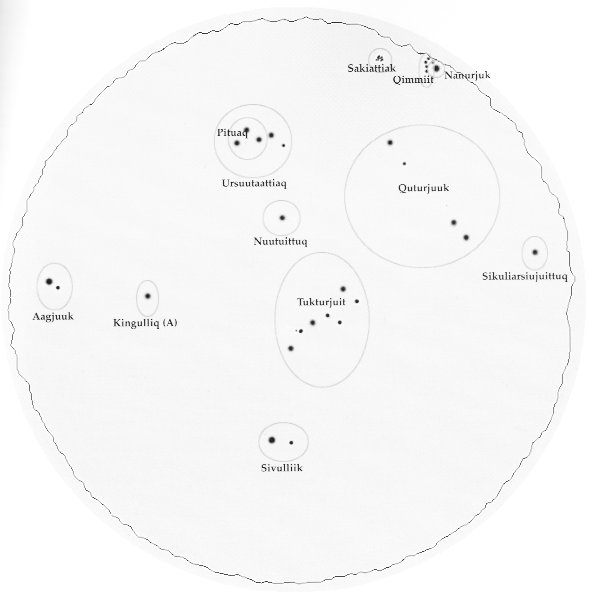The pair of suns at the
beginning of line Cb8 could possibly represent
or allude to Twin Stars standing at
'dawn' and 'sunset':
|
October 5 |
6 |
7 (280) |
8 |
9 |
 |
 |
 |
 |
 |
|
Cb8-1 (564) |
Cb8-2 |
Cb8-3 |
Cb8-4 |
Cb8-5 |
|
Hetu erua |
tagata rere
ki te ragi |
te hokohuki |
te moko |
|
ξ² Centauri
(197.9),
Apami-Atsa
(198.5) |
Diadem (198.9),
Al Dafīrah (199.4) |
σ Virginis
(200.4) |
ι Centauri
(201.4) |
Mizar (202.4) |
Sadalmelik (647) |
|
April 7 (462) |
8 |
9 |
10 (100) |
11 |
|
Revati-28 |
κ Tucanae (17.6) |
no star listed |
Ksora (20.1) |
no star listed |
|
REVATI
(16.9), ν Phoenicis (17.4) |
Although the Gemini twins once
were at the March equinox some other pair
of stars could have taken over their function:
...
I knew of two men who lived in another
settlement on the Noatak river. They did
not believe in the spirit of the string figures,
but said they originated from two stars,
agguk, which are visible only when the sun
has returned after the winter night. One of
these men was inside a dance-house when a flood
of mist poured in ... His two companions rapidly
made and unmade the figure 'Two Labrets', an
action intended to drive away the spirit of the
string figures, uttering the usual formula ...
but the mist kept pouring in ...
...
Again, in a diary entry dated 18 December 1913
Jenness notes the same Alak telling him
that 'they never played cat's cradles while two
stars called agruk were visible, just
before the long days of summer... They played
other games then, like whizzer [a noise maker]
...
...
Alak's comments indicate that, for the
Noatak area at least, the appearance of
Aagjuuk, rather than the Sun, signalled the
end of the string-game season. And the opinion
... that string figures came from, and are
therefore related to, Aagjuuk may have
given rise to the prohibition against playing
them after the solstice appearance of these
stars. It is also possible that the string game
mentioned by Alak - 'Two Labrets' -
rapidly made and unmade in an attempt to drive
off the 'string figure spirit', was intended to
symbolize Aagjuuk's two stars and so
confound the constellation with its own likeness
or spirit.
...
Etalook refers to the 'aagruuk' as
'labrets' (the circular lower-lip ornaments of
some Western Arctic Eskimo groups, certainly
evoke an astral image if we recall that early
Inuit gaphic representations of stars were
usually circular ...) giving them, it seems, an
alternate name, ayaqhaagnailak, 'they
prohibit the playing of string games': They are
the ones that discourage playing a string
game... That's what they're called,
ayaqhaagnailak, those two stars... When the
two stars come out where is no daylight, people
are advised not to play a string game then, but
with hii, hii, hii... toy noisemakers of
wood or bone and braided sinew
...

|
"While the stars Altair and
Tarazed can be seen during the
fall months, late in the evening
to the southwest, they are only
recognized as Aagjuuk by
Inuit following their
first morning appearance on the
north-eastern horizon, usually
around mid-December. Throughout
January, February, and March
they are seen during the
pre-dawn hours but thereafter
are rapidly taken over by
sunlight as the days lengthen."
"By all accounts, Aagjuuk
was for Inuit everywhere
one of the most important
constellations. It seems to have
been known by this name, or a
variant of it, across the entire
Arctic."
"The linking of Aagjuuk's
stars with dawn and solstice
were the characteristic feature
of this constellation recognized
as well by other Arctic peoples,
in particular the Chukchis:
'The stars Altair and Tarazed of
the constellation Aquila are
singled out by the Chukchis
as a special constellation,
Peggittyn. This
constellation is considered to
bring the light of the new year,
since it appears on the horizon,
just at the time of winter
solstice."
"The meaning of the term
Aagjuuk is not clear.
Etymologically, Fortescue has
postulated a link between the
aayģuk and the Yup´ik
term for arrow, 'as if the dual
of aayģu,
arrow..."
"An emphatic and, in our
context, attractive explanation
of the constellation's name is
found in a legend from
Noatak, Alaska. Here
agruks (Aagjuuk)
are said to be 'the two sunbeams
of light cast by the sun when it
first reappears above the
horizon in late December' ...
The legend ... then goes on to
recount how these two sunbeams
were transformed into stars and
so confirms, from the
Inuit point of view,
the various and widespread
connections between the
Aagjuuk stars, winter
solstice, daylight, and the
return of the Sun."
"Most published descriptions of
Aagjuuk tend to leave
the impression that it suddenly
appears on cue as if out of
nowhere... This definition is
somewhat misleading because
throughout the autumn and winter
months at latitudes above the
Arctic Circle
Aagjuuk's principal
star, Altair, is one of the
brightest and most visible stars
in the south and western sectors
of the sky. But so completely is
Aagjuuk identified
with mid-December and the winter
solstice that one
Igloolik elder,
invited to point to the
constellation in early November,
firmly replied that we would not
see it until around Christmas,
and this in spite of the fact
that Altair was at the time in
full view to the southwest."
(Arctic Sky) |
|




